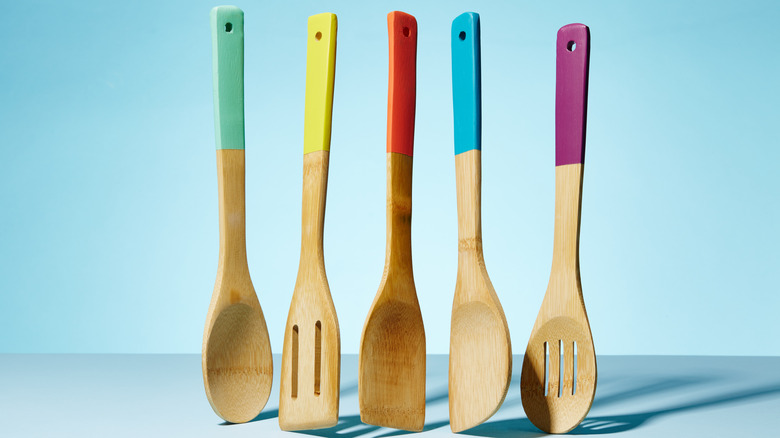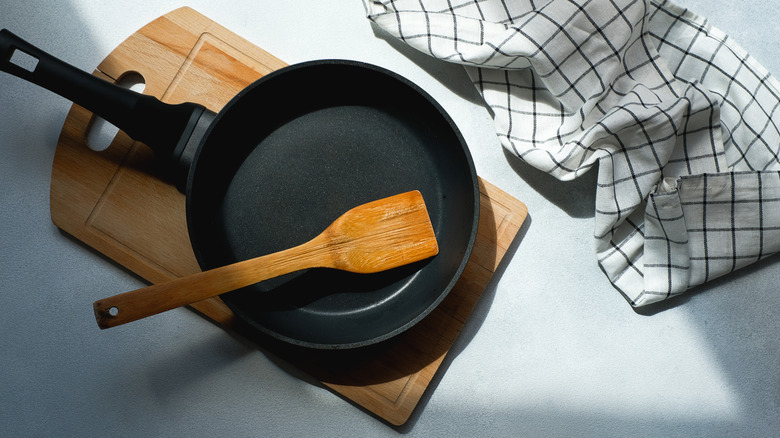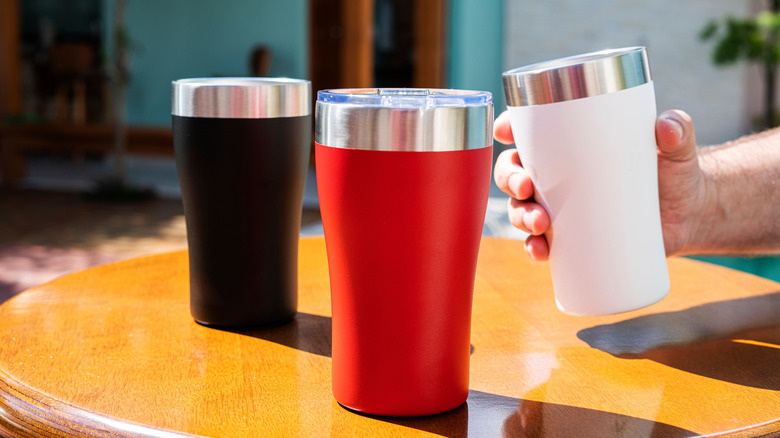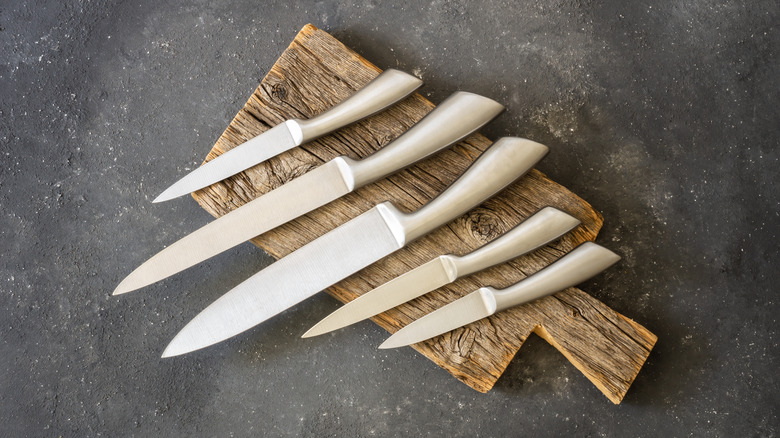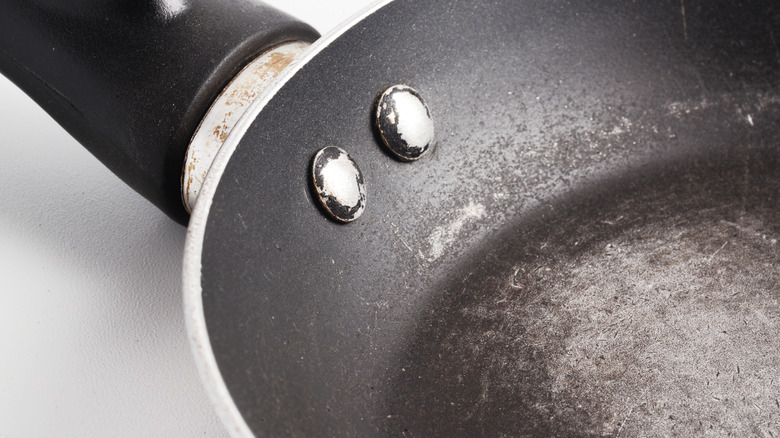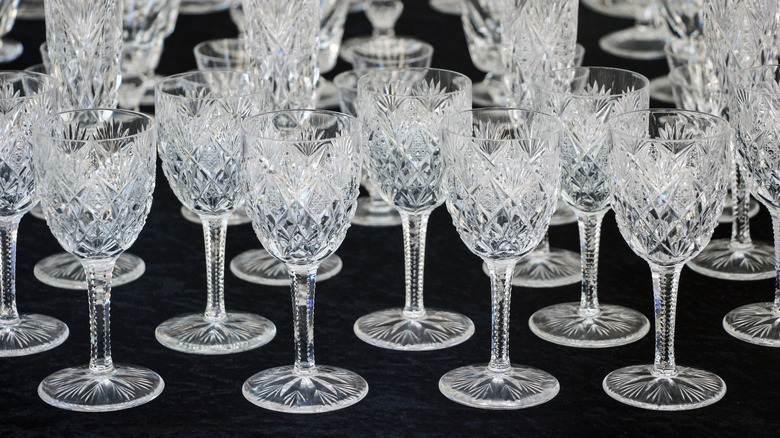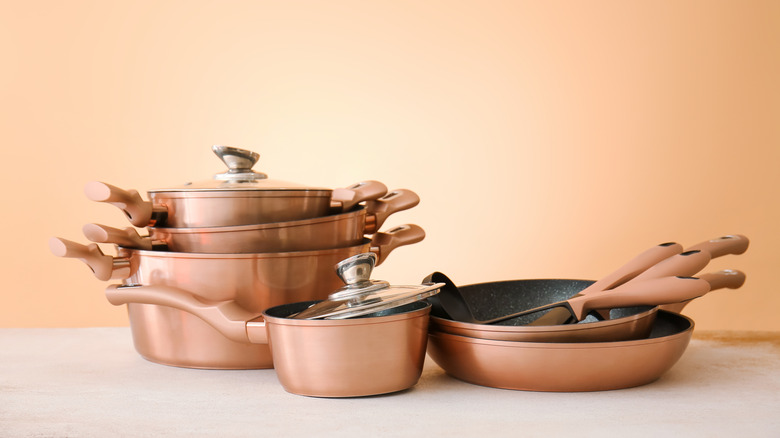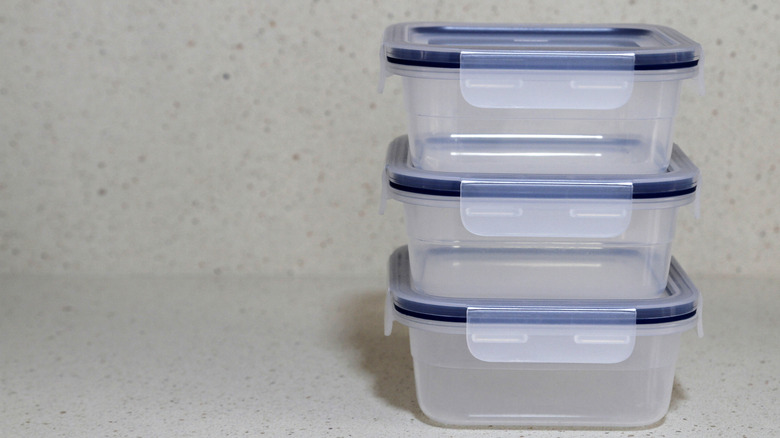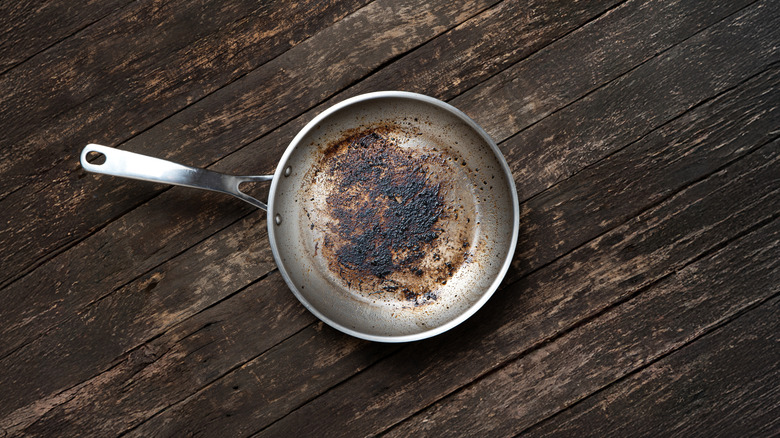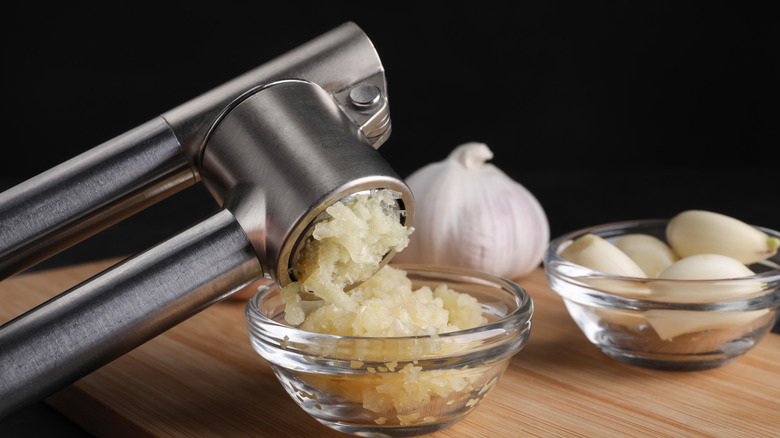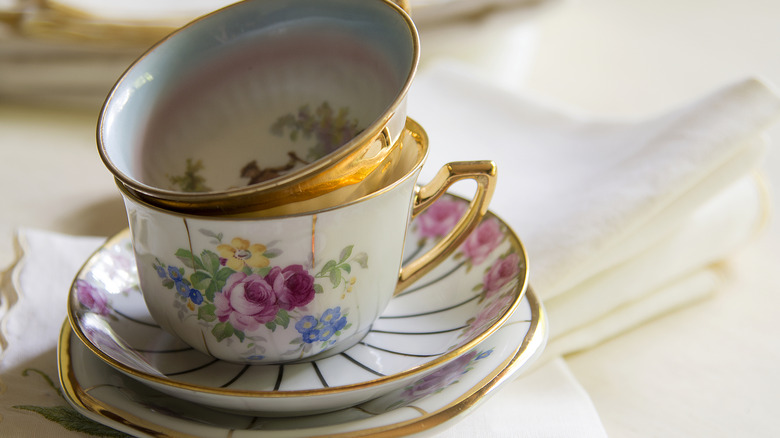11 Kitchen Items You Should Never Put In The Dishwasher
Dishwashers are one of the greatest time-saving tools in the kitchen, offering an easy way to clean up after a long cooking session. But while many of us are tempted to toss everything in the dishwasher and hit start, not all kitchen items are built to withstand its high heat, strong water pressure, and harsh detergents. Some materials degrade faster in the dishwasher, while others can become safety hazards or lose functionality over time. If you've ever pulled out a warped cutting board or a dulled knife, you've already seen the downside of relying too much on this convenience.
The truth is, certain cookware and utensils are much better off washed by hand. Ignoring manufacturer care instructions can shorten the lifespan of your favorite tools, damage surfaces that affect cooking performance, or even introduce safety issues. This isn't just about preserving appearances — it's also about protecting food safety and maintaining the tools you rely on every day.
To help you keep your kitchen gear in great shape, we've rounded up a list of common items that experts and manufacturers agree should stay out of the dishwasher. Whether you're a seasoned home chef or someone just starting to stock a kitchen, this guide will save you money, hassle, and a few regrets down the road.
Wooden utensils
Wooden utensils may seem like old-fashioned kitchen tools, but they've stood the test of time for a reason. Their versatility, durability, and gentle touch on cookware make them a staple in home and professional kitchens alike. However, these benefits quickly diminish when they're exposed to the harsh conditions of a dishwasher. The combination of hot water, steam, and aggressive detergent breaks down the wood's structure over time, causing it to swell, split, or warp. Once this happens, the utensil can become rough, retain bacteria, and even leach unwanted flavors into food.
Prolonged exposure to moisture is the primary issue. Wood is porous, and when it soaks up water, it expands. In a dishwasher, that soaking is coupled with high temperatures and drying cycles that force the water back out, leaving the wood cracked or misshapen. It's not just aesthetic damage — cracks can make cleaning harder and reduce the utensil's lifespan significantly.
For best results, wooden spoons, spatulas, and cutting boards should be hand washed with mild soap and warm water, then dried immediately. Occasionally rubbing them with food-safe mineral oil can also help preserve the wood's integrity and keep the surface smooth. A little extra care goes a long way in making sure your wooden utensils remain safe, functional, and looking great for years.
Cast iron pans
Cast iron cookware is prized for its ability to retain heat, deliver even cooking, and develop a natural non-stick surface through seasoning. That seasoning, however, is delicate and can be easily destroyed in the dishwasher. While a quick rinse might be tempting, the combination of high heat, water pressure, and harsh detergents in most dishwashers can strip away the carefully built-up oil layers that make cast iron perform at its best.
Seasoning is essential for protecting the pan from rust and for providing that signature slick surface. Cast iron should never be soaked or left wet — conditions that are unavoidable in a dishwasher cycle and can lead to rust and damage the seasoning. Water exposure alone can lead to surface corrosion, but when combined with the degreasing power of dishwasher detergent, the damage is swift and often permanent.
Even enameled cast iron pans, which offer added protection through a coated surface, benefit from gentle hand washing. The enamel may protect the metal, but the coating itself can dull or chip if it bangs into other cookware or is exposed to overly aggressive cleaning cycles. To preserve cast iron's longevity and performance, stick to hand washing with hot water and a non-abrasive sponge. After cleaning, always dry immediately and reapply a thin layer of oil if needed to maintain the pan's seasoned surface.
Insulated mugs and thermoses
Insulated mugs and thermoses are designed to keep drinks hot or cold for hours thanks to a vacuum-sealed barrier between inner and outer walls. But while these vessels are incredibly convenient, tossing them in the dishwasher could quietly ruin them over time. The intense heat and steam of a typical cycle can compromise that vacuum seal, turning a high-performance bottle into little more than a regular cup.
Even if some insulated drinkware is labeled as dishwasher-safe, it's best to proceed with caution. The heat can cause expansion and contraction in the layers of the container, potentially breaking the seal. Once that barrier is breached, the container can no longer retain temperature effectively. Additionally, water might seep into the space between the walls, leading to trapped moisture and eventual mold or rust.
Some lids also contain small parts and rubber gaskets that can degrade or warp in the dishwasher, making the container harder to clean or less leak-proof over time. While it may seem like a hassle to hand wash, using warm water, mild soap, and a bottle brush can significantly extend the life of insulated drinkware. If you want to maintain both the function and safety of your thermal mugs and bottles, keeping them out of the dishwasher is the smart move.
Sharp knives
Knives are among the most frequently used and most important tools in any kitchen. But tossing them into the dishwasher after prep may be one of the fastest ways to shorten their lifespan. The combination of high heat, harsh detergents, and jostling during the wash cycle can dull the blade, weaken the handle, and compromise performance, often without any visible signs.
Knives are especially vulnerable to the heat and salts used in dishwasher cycles, which can degrade the fine edge of the blade. What's more, sharp edges can bang against other utensils or the dishwasher basket, creating microchips that are difficult to detect but have a big impact on cutting ability.
Handles, particularly wooden or composite ones, are another weak point. Moisture from repeated dishwasher use can seep into tiny crevices, causing the material to swell or crack. This not only makes the knife uncomfortable to use but also creates a potential safety issue over time.
To maintain sharpness and structural integrity, hand washing is the way to go. A quick clean with mild soap and warm water, followed by immediate drying, is all it takes. And when storing, keep knives in a block or on a magnetic strip — never loose in a drawer. Proper care ensures your knives stay sharp, safe, and effective for years to come.
Nonstick pans
Nonstick cookware offers everyday convenience, especially for quick meals and easy cleanup. But while many pans are labeled as dishwasher-safe, that doesn't mean it's the best option. Frequent dishwashing can significantly reduce a nonstick pan's performance and lifespan, especially if you're using it multiple times a week.
The high temperatures and abrasive detergents in dishwashers break down the coating over time. This degradation often starts with subtle surface wear, eventually leading to visible peeling or flaking. Once the nonstick coating starts to deteriorate, not only does food begin sticking more easily, but the exposed material underneath can also affect the taste and safety of what you're cooking.
Different types of nonstick pans react differently in dishwashers. While PTFE-based coatings (aka Teflon) are more resilient, ceramic-coated pans tend to break down faster under these conditions. Regardless of the material, all nonstick surfaces will benefit from a gentler cleaning approach. Hand washing with a soft sponge and mild soap is enough to remove residue without wearing down the coating.
Maintaining the nonstick surface means avoiding stacking the pan directly against other cookware: Use a towel, paper plate, or other protective layer between pans when stacking. With the right care, a good-quality nonstick pan can last several years. Keeping it out of the dishwasher is one of the easiest ways to protect that investment.
Crystal and delicate glassware
Crystal stemware and delicate glassware are built for elegance, not the punishing environment of a dishwasher. While some modern pieces might claim dishwasher safety, fragile items like hand-blown crystal or antique china are best kept out of the machine altogether. The combination of high-pressure water, abrasive detergents, and heat can cause cloudiness, surface etching, and chipping — even if the damage isn't immediately visible.
Most manufacturers recommend hand washing china and crystal unless they specifically label them as dishwasher-safe. Delicate pieces are particularly vulnerable to chipping when they bump against other dishes during the wash cycle. Metallic rims or hand-painted details may also fade or peel over time when exposed to dishwasher heat and chemicals.
Hand washing is both safer and more effective for these fragile items. Using warm water, a small amount of mild dish soap, and a soft cloth or foam brush helps preserve the finish and appearance. To prevent chips or cracks during cleaning, place a towel at the bottom of the sink and wash items individually. Allowing them to air dry upside down on a soft towel or gently drying with a microfiber cloth also reduces the chance of breakage.
When cared for properly, quality glassware can last a lifetime. The extra effort of hand washing is a small trade-off for preserving its clarity and charm.
Copper cookware
Copper cookware brings undeniable style to any kitchen, but keeping that signature shine takes a little extra care. While these pans are often lined with materials like stainless steel or enamel, the outer copper layer remains highly reactive to heat and chemicals, making the dishwasher a risky place for them.
Copper items should never go in the dishwasher. The high temperatures and strong detergents commonly used in dishwashing cycles can accelerate tarnishing and strip away the bright finish. Even if the cookware has a protective lacquer, repeated exposure to dishwashing conditions may cause the coating to wear down, leaving the raw metal exposed to oxidation. This results in a dull, darkened appearance and can cause permanent discoloration.
Beyond aesthetics, the surface of copper is relatively soft and prone to scratching. A dishwasher's harsh environment — including contact with other items — increases the likelihood of surface damage. To preserve copper cookware's longevity and keep it looking polished, hand washing is the safest option. Use warm water, a mild dish soap, and the soft side of a sponge or dishcloth. Avoid abrasive scrubbing tools, as they can leave behind fine scratches that are difficult to buff out later.
Plastic containers
Plastic containers are among the most commonly used kitchen items, but they're also among the most vulnerable in the dishwasher. While some containers are marked as dishwasher-safe, especially those labeled for reuse, many are not designed to handle high heat or prolonged exposure to water. Without proper labeling, it's best to avoid sending plastic through a wash cycle entirely.
Plastic's reaction to dishwasher conditions varies by type. Disposable containers, like takeout tubs or single-use water bottles, are especially risky — they're made from plastics that soften, warp, or even leach chemicals when heated. Even reusable plastic items, like lunch containers and baby bottles, should only be placed on the top rack and kept away from high-heat or sanitizing cycles. Prolonged exposure to these conditions can degrade the plastic's integrity, causing warping, staining, and potential safety concerns.
Another concern is the presence of BPA and BPA alternatives. While many products now advertise themselves as BPA-free, similar compounds like BPS or BPF may still react under heat. This makes it critical to not only confirm dishwasher compatibility but also consider the material's long-term safety under repeated use. The safest approach? Stick with hand washing plastic items using mild soap and warm water. It may take a bit more time, but it's a worthwhile trade-off for preserving shape, safety, and usability.
Aluminum pans
Aluminum pans are lightweight, affordable, and heat up quickly, making them a kitchen staple. But if you're running them through the dishwasher, you might be shortening their lifespan without even realizing it. Bare aluminum, especially when not anodized or coated, reacts poorly to the environment inside a dishwasher. What comes out looking clean may also be discolored, pitted, or structurally weakened.
Aluminum is a reactive metal, and the strong alkaline detergents commonly used in dishwashers can trigger chemical reactions (much like using tomatoes when cooking with aluminum pots). These reactions strip away the outer layer of the metal, causing oxidation that appears as dark or cloudy spots. In more severe cases, the surface may become rough or develop a white, chalky film. This isn't just a cosmetic issue — over time, oxidation can erode the surface, altering how the pan conducts heat and affecting its durability.
Anodized aluminum, which has been treated to prevent oxidation, is more resistant but still not immune to the dishwasher's harsh environment. Repeated exposure can dull the finish and reduce non-stick properties if they exist.To protect your aluminum cookware, hand washing is the best route. Use warm water, gentle dish soap, and a soft sponge to clean without damaging the surface. For tough stains or discoloration, a mixture of baking soda and water can help lift marks without abrasion.
Graters, garlic presses, and microplanes
Kitchen tools like graters, garlic presses, and microplanes are small but mighty. They make quick work of prepping garlic, cheese, citrus, and more — but cleaning them is another story. Despite their sturdy appearance, these tools are among the trickiest to wash properly, and relying on the dishwasher may not get the job done.
Even a full dishwasher cycle often fails to dislodge sticky or stringy food like ginger or zest. The issue lies in the tiny, sharp perforations and narrow crevices where food gets wedged and dries quickly. Once hardened, these bits are stubborn, and the dishwasher's high-pressure spray isn't always precise enough to flush them out.
Worse still, abrasive dishwasher detergents and prolonged exposure to water can wear down the sharpness of grating surfaces or cause rust on cheaper metal tools. Steel wool and aggressive scrubbers can dull sharp edges or leave behind fragments, making them a poor choice for cleaning these tools.
The best cleaning method? Rinse immediately after use and scrub in the direction of the blades with a soft brush or sponge. For dried-on bits, soaking in warm water can loosen residue, making hand washing much more effective. By avoiding the dishwasher, you protect both the tool's function and its lifespan.
Decorated or antique dishes
Decorated and antique dishes often carry sentimental value — and sometimes even health risks — if not handled properly. These pieces, especially those with metallic trim, hand-painted designs, or vintage glazes, aren't built to endure the rigors of a dishwasher. High temperatures, water pressure, and detergent can cause fading, chipping, and in some cases, leaching of harmful materials.
According to Whirlpool's dishwasher safety guide, fragile and decorative dishes are among the items best kept out of the dishwasher. Metallic embellishments can tarnish or flake, and hand-painted details may fade quickly under heat and detergent exposure. The risk is even greater with older dishes, particularly those made before the 1970s, as their glazes might contain lead. If these pieces deteriorate in the dishwasher, lead can potentially leach into food when reused, posing a serious safety concern.
Even if a piece looks intact after a cycle or two, repeated washing can cause gradual wear. Over time, this degradation affects both appearance and structural integrity, turning a cherished heirloom into a compromised kitchen item.
To preserve these dishes, always opt for hand washing with warm water and mild soap. Use a soft sponge and dry gently with a towel. When in doubt, treat decorative or antique pieces as display items only — it's the best way to keep them beautiful and safe for generations.

